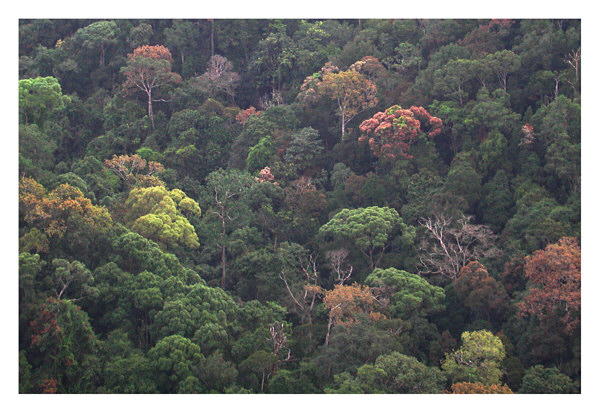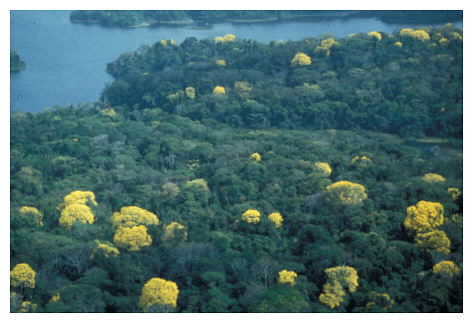| |
|
|
|
|

Canopy of lowland hill dipterocarp forest in Sinharaja taken from the top of
a lowland hill - Sinharaja
(about 800m asl). It shows
different species in different stages of leaf flushing (light green) and
early
fruiting (pinkish - red) stages
but none in the picture in bloom. Source: Nimal Gunatilleke, Universität
Peradeniya
Spatial patterns
of tropical tree species retain little signature of species interactions
A persistent challenge in
ecology is to explain the high species diversity of tropical forests. One
approach to facing this challenge is to analyze the spatial patterns of
explicit maps of individual tree locations, which should retain a signal of
processes promoting coexistence. Previous research suggest strong positive
or negative associations e.g., as a result of competitive or facilitative
interactions. To our surprise, we have discovered in our data set collected
at a 25ha plot of tropical forest in Sri Lanka that the majority of all
species pairs showed segregated spatial patterns, or only a partial overlap,
and not more than 6% of the species pairs showed significant associations.
We summarize our findings in an article just published in the leading
journal The American Naturalist. Our analyses are based on a fully mapped
25ha plot of tropical rain forest at the Sinharaja UNESCO World Heritage
Site in Sri Lanka where all individuals ≥ 1 cm diameter at breast height
have been mapped, measured, and identified to species. This plot is part of
the network of the Center for Tropical Forest Science (CTFS;
http://www.ctfs.si.edu) and has several series of closely related congeneri
and partially sympatric species; the majority of these are endemic to Sri
Lanka.
To paint an overall picture of the association between tree species we
analyzed the spatial patterns of several thousand species pairs. In a first
step, we explored how species pairs were distributed relative to each other.
In more than half of all cases we found segregated patterns meaning that the
two species were basically distributed in disjunctive patches within the
plot. Only in about 6% of all cases we found a co-occurrence pattern. It
thus looks as if the species were distributed in this forest in a way that
minimizes the opportunities of individual trees of different species to come
into close contact with each other.
In a second step, we addressed the question whether the spatial pattern of
species pairs showed a signature of significant positive or negative
association. To this end we used advanced spatial-statistical methods,
so-called point-pattern analyses, which are used, for example, to study the
spatial structure of galaxies. However, the problem of studying spatial
association between species is that habitat association may confound the
effect of plant-plant interactions because both can produce locally elevated
or reduced species co-occurrence. The breakthrough of our analysis is that
we found a way to disentangle these two effects. This allowed us to look at
our data in a novel way.
Previous studies showed that growth and survival of trees depend quite
strongly on their neighbors. We therefore expected strong signatures of
positive or negative interactions between species which such as those caused
by competition or facilitation. However, to our surprise we found that only
approximately 6% of the 2070 species pairs showed significant associations.
This apparent contradiction raises the question why such non-neutral
processes, which should also operate at Sinharaja, did not leave a
detectable signature in the spatial pattern. We hypothesize that non-neutral
processes affecting tree performance equilibrate and produce in most cases
neutral bivariate patterns in the spatial distribution of trees. This can be
interpreted as a strong argument in favor of neutral theory. A second
complementary hypothesis is that trees of two given species just “meet” too
seldom to produce specific associations and that therefore the set of
species neighbors encountered by individuals of a given species is quite
variable and not predictable for the individual.
Our finding of lack of species associations is a novel pattern and a step
towards an understanding of the complexities of the origin and maintenance
of species richness in tropical forests.
Press Release 04/2008
New method for measuring
biodiversity
How individual species help structure the biodiversity
of tropical rainforests
Leipzig. German and Sri Lankan researchers have
developed a new method for measuring the impacts of species on local
biodiversity. It makes it possible to determine whether a certain species
promotes or suppresses species diversity. The new method extends a procedure
familiar to biologists that involves investigating species numbers in
relation to area (the species-area relationship, or SAR), by adding
sophisticated statistical methods so that it can be used to describe the
role of individual species in their impact on biodiversity. This
individualised method (‘individual species-area relationship’, or ISAR)
makes it easier to identify key species. “We are effectively looking at
diversity in the ecosystem through the glasses of the individual species,”
says co-author Dr Andreas Huth of the UFZ. This means that in future it will
be easier to understand the role of individual species in ecosystems and to
implement targeted protection measures for key species. In addition, the
method can be used to investigate better the ecological consequences of
changes in land use.
The researchers used their new method to evaluate unique data from two
tropical rainforests in Sri Lanka and Panama that are part of a network
coordinated by the Center for Tropical Forest Science (CTFS;
http://www.ctfs.si.edu). Within this network, every single tree with a trunk
bigger than a pencil has been mapped and monitored for years on about a
dozen selected sample plots, some as large as 50 hectares, in tropical
rainforests around the globe. The researchers compared in their study around
40 000 larger trees in the tropical rainforest on Barro Colorado Island,
Panama, with those in the Sinharaja World Heritage Site in Sri Lanka. To
their surprise, more than two third of all species did not leave
identifiable signatures on spatial diversity. The other tree species had an
impact on local biodiversity only in their immediate surroundings, within a
radius of up to 20 metres, but not on a large scale. These findings support
the much-debated ‘neutral theory’, according to which species
characteristics are unimportant for certain community attributes and play
only a subsidiary role in the stability and diversity of ecosystems. The
study reveals that the two tropical forests lacked any key species
structuring species diversity at larger scales, suggesting that ‘‘balanced’’
species–species interactions may be a characteristic of these species rich
forests. Dr Thorsten Wiegand says, “Biodiversity researchers have not been
able to agree on which processes permit a high level of species diversity to
emerge, and which processes keep these complicated systems stable”.
On the research plot in Panama there were lots of ‘repellent’ species. By
contrast, the one in Sri Lanka is dominated by ‘attractor’ species, i.e.
species that promote biodiversity. “It is not yet known why these two
tropical rainforests are so different in this regard” say Savitri
Gunatilleke and her husband Nimal, both professors at the University of
Peradeniya, “but our method is a leap forward in an understanding of the
complexities of the origin and maintenance of species richness in tropical
forests”. After all, the method was being used for the first time. “We first
used the new method in tropical rainforests, but it is universally
applicable and can be used for plants in all ecosystems,” says Dr Andreas
Huth of the UFZ. The new method closes a gap between rather more crude
descriptions of biodiversity (for the whole ecosystem) and extremely
detailed analyses (interactions between individual species). In future then,
the models already developed at the UFZ for sustainable forestry management
will also be optimised.

Canopy of the seasonally moist
tropical forest at Barro Colorado Island (BCI),
Panama, with bright yellow flowering
trees of the golden guayacan, Tabebuia
guayacan (Seem.) Hemsl. Source:
Smithsonian Tropical Research Institute,
Center for Tropical Forest Science.
|
|
|
|
|
|
|

